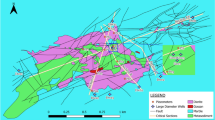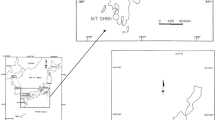Abstract
As groundwater activity develops in a landslide system, the water–rock (soil) interaction increasingly influences the development of the landslide hazard. In this paper, Huangtupo landsli de was chosen as the subject of our research, which is located beside the Three Gorges Reservoir and the deformation continued for a long time. First, based on a comprehensive field survey, ten types of bad geological elements which probably induce the deformation were collected from different parts of landslide. These include a soft rock layer, the sliding soil, a weak intercalation and the typical rock close to the slip zone. Then, to trace the internal relationships among these samples, the microstructure, chemical composition of minerals, the migration and evolution of clay minerals, also the particle size distribution characteristics of all the samples were analyzed separately. Comparison of the result shows, that the evolutionary paths are very obvious among these samples. With the activities of water–rock (soil) interaction, the formation and evolution of main bad geological elements can be summarized. Afterwards, the detailed mechanism of interaction is revealed by focusing on four samples which compose one of these three paths, using additional data from physical and mechanical tests, the study shows how water–rock (soil) interaction affects the microstructure and weakens the mechanical properties of rock and soil. The presented detailed research probes the water–rock (soil) interaction mechanism specifically for Huangtupo riverside landslide as a case study. Furthermore, the applied multi-sample dynamic tracing method is verified as a means to discover and illustrate the deformation mechanism of landslides.

















Similar content being viewed by others
References
Beaucaire C, Michelot JL, Savoye S, Cabrera J (2008) Groundwater characterisation and modelling of water–rock interaction in an argillaceous formation (Tournemire, France). Appl Geochem 23(8):2182–2197
Chigira M, Oyama T (1999) Mechanism and effect of chemical weathering of sedimentary rocks. Eng Geol 55:3–14
Deng QL (2000) Slope deformation structure. China University of Geosciences Press, Wuhan (in Chinese with English abstract)
Deng QL, Zhu ZY, Cui ZQ, Wang XP (2000) Mass rock creep and landsliding on the Huangtupo slope in the reservoir area of the Three Gorges Project, Yangtze River, China. Eng Geol 58:67–83
Fitz-Diaz E, Hudleston P, Siebenaller L, Kirschner D, Camprubi A, Tolson G, Puig TP (2011) Insights into fluid flow and water-rock interaction during deformation of carbonate sequences in the Mexican fold-thrust belt. J Struct Geol 33(8):1237–1253
Hseung Y, Hsu CC (1964) Frequency distribution of clay minerals in the soils of China. Acta Pedol Sin 12:266–274 (in Chinese with English abstract)
Jian WX, Wang ZJ, Yin KL (2009) Mechanism of the Anlesi landslide in the Three Gorges Reservoir, China. Eng Geol 108:86–95
Jiang JW, Ehret D, Xiang W, Rohn J, Huang L, Yan SJ, Bi RN (2011a) Numerical simulation of Qiaotou Landslide deformation caused by drawdown of the Three Gorges Reservoir, China. Environ Earth Sci 62:411–419
Jiang JW, Xiang W, Zhang XY (2011b) Research on mechanical parameters of intact sliding zone soils of Huangtupo landslide based on CT scanning and simulation tests. Chin J Rock Mech Eng 30:1025–1033 (in Chinese with English abstract)
Li SD, Li X, Zhang NX, Liu YH (2006) Water-rock interaction of clay gouged intercalation sludging process of Baota landslides in Three Gorges Reservoir area. Rock Soil Mech 27:1841–1846 (in Chinese with English abstract)
Li SD, Li X, Wu J, Liu YH (2007) Evolution process and pattern of sliding zone in large consequent bedding rock landslide. Chin J Rock Mech Eng 26:2373–2480 (in Chinese with English abstract)
Liu S, Zhang SX, Li JF (2001) Investigation of a landslide in the new site of Badong County by integrated geophysical survey. Sci China Series D-Earth Sci 44(5):426–436
Liu XR, Fu Y, Wang YX, Huang LW, Qin XY (2008) Deterioration rules of shear strength of sand rock under water–rock interaction of reservoir. Chin J Geotech Eng 30:1298–1302 (in Chinese with English abstract)
Locsey KL, Grigorescu M, Cox ME (2012) Water-rock interactions: an investigation of the relationships between mineralogy and groundwater composition and flow in a subtropical basalt aquifer. Aquat Geochem 18(1):45–75
Lucas Y, Schmitt AD, Chabaux F, Clement A, Fritz B, Elsass P, Durand S (2010) Geochemical tracing and hydrogeochemical modelling of water-rock interactions during salinization of alluvial groundwater (Upper Rhine Valley, France). Appl Geochem 25(11):1644–1663
Luo HM, Tang HM, Zhang GC, Xu WY (2008) The influence of water level fluctuation on the bank landslide stability. Earth Sci J China Univ Geosci 33:687–692 (in Chinese with English abstract)
Mohamed AMO (2000) The role of clay minerals in marly soils on its stability. Eng Geol 57:193–203
Seodon J, Eberl DD (1989) Illite. Rev Mineral 13:495–544
Shao HB, Ray JR, Jun YS (2010) Dissolution and precipitation of clay minerals under geologic CO(2) sequestration conditions: CO(2)-brine-phlogopite interactions. Environ Sci Technol 44(15):5999–6005
Shen ZL, Wang YX (2002) Review and outlook of water–rock interaction studies. Earth Sci J China Univ Geosci 27:127–133 (in Chinese with English abstract)
Shuzui H (2001) Process of slip-surface development and formation of slip-surface clay in landslides in Tertiary volcanic rocks, Japan. Eng Geol 61:199–219
Tang LQ, Nie DX, Ren GM (2003) The relational analysis between the clay grain content and strength characteristics of weak intercalated layer. Chin J Geol Hazard Control 14:56–60 (in Chinese with English abstract)
Wang GX, Xu JL, Liu GD, Li CZ (2007) Landslidology and landslide control technique. China Railway Publishing House, Beijing, pp 140–152 (in Chinese with English abstract)
Wen BP, Aydin A (2005) Mechanism of a rainfall-induced slide-debris flow: constraints from microstructure of its slip zone. Eng Geol 78:69–88
Wen BP, Chen HY (2007) Mineral compositions and elements concentrations as indicators for the role of groundwater in the development of landslide slip zones: a case study of large-scale landslides in the Three Gorges area in China. Earth Sci Front 14:98–106 (in Chinese with English abstract)
Xu ZM, Huang RQ, Fan ZG (2005a) Water-rock interaction in process of landslide preparing and triggering. J Nat Disasters 14:1–9 (in Chinese with English abstract)
Xu ZM, Huang RQ, Tang ZG, Wang SD (2005b) Clay minerals and failure of slopes. Chin J Rock Mech Eng 24:729–740 (in Chinese with English abstract)
Xu WJ, Hu RL, Yue ZQ (2009) Development of random mesostructure generating system of soil-rock mixture and study of its mesostructural mechanics based on numerical test. Chin J Rock Mech Eng 28:1652–1665 (in Chinese with English abstract)
Yan CJ, Tang HM, Chen JY, Sun YZ (2002) Studies of soil in microstructures and compositions slipping zone in reservoir district of Three Gorges Project. Rock Soil Mech 23(supp):23–26 (in Chinese with English abstract)
Zhu C, Lu P (2009) Alkali feldspar dissolution and secondary mineral precipitation in batch systems: 3. Saturation states of product minerals and reaction paths. Geochim Cosmochim Acta 73(11):3171–3200
Acknowledgments
This study was carried out in the framework of the bilateral cooperative project of China University of Geosciences (Wuhan) and Friedrich-Alexander-University Erlangen-Nuremberg (Germany). The authors gratefully acknowledge the financial support of the German Centre for Aviation and Space Travel (DLR), the International Bureau of the German Federal Ministry of Education and Research (BMBF) and the Three Gorges Research Center for Geo-hazard, Ministry of Education.
Author information
Authors and Affiliations
Corresponding author
Rights and permissions
About this article
Cite this article
Jiang, Jw., Xiang, W., Rohn, J. et al. Research on water–rock (soil) interaction by dynamic tracing method for Huangtupo landslide, Three Gorges Reservoir, PR China. Environ Earth Sci 74, 557–571 (2015). https://doi.org/10.1007/s12665-015-4068-5
Received:
Accepted:
Published:
Issue Date:
DOI: https://doi.org/10.1007/s12665-015-4068-5




